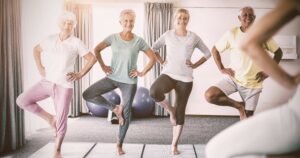Ask Mr. Pedometer and Friends….Prevent Falls
Q: Mr. Pedometer, an elderly (read: older than me) friend of mine fell recently, and now she’s afraid to leave her house, even for short walks. I’ve told her that inactivity is bad for her, but she is afraid of falling again. Any advice?
A: Sadly, you both are correct: Assuming that your friend is over 65, once she has fallen, her chances are doubled that she will fall again. And, as you have warned her, limiting her movement can cause lower body weakness that actually increases her risk of falling. This is National Fall Prevention Week, and here is some important information from the Center for Disease Control and Prevention (cdc.gov):
Important Facts about Falls
Each year, millions of older people—those 65 and older—fall. In fact, more than one out of four older people falls each year, but less than half tell their doctor. Falling once doubles your chances of falling again.
Falls Are Serious and Costly
- One out of five falls causes a serious injury such as broken bones or a head injury,
- Each year, 3 million older people are treated in emergency departments for fall injuries.
- Over 800,000 patients a year are hospitalized because of a fall injury, most often because of a head injury or hip fracture.
- Each year at least 300,000 older people are hospitalized for hip fractures.
- More than 95% of hip fractures are caused by falling, usually by falling sideways.
- Falls are the most common cause of traumatic brain injuries (TBI).
- In 2015, the total medical costs for falls totaled more than $50 billion. Medicare and Medicaid shouldered 75% of these costs.
What Can Happen After a Fall?
Many falls do not cause injuries. But one out of five falls does cause a serious injury such as a broken bone or a head injury. These injuries can make it hard for a person to get around, do everyday activities, or live on their own.
- Falls can cause broken bones, like wrist, arm, ankle, and hip fractures.
- Falls can cause head injuries. These can be very serious, especially if the person is taking certain medicines (like blood thinners). An older person who falls and hits their head should see their doctor right away to make sure they don’t have a brain injury.
- Many people who fall, even if they’re not injured, become afraid of falling. This fear may cause a person to cut down on their everyday activities. When a person is less active, they become weaker and this increases their chances of falling.
What Conditions Make You More Likely to Fall?
Research has identified many conditions that contribute to falling. These are called risk factors. Many risk factors can be changed or modified to help prevent falls. They include:
- Lower body weakness
- Vitamin D deficiency (that is, not enough vitamin D in your system)
- Difficulties with walking and balance
- Use of medicines, such as tranquilizers, sedatives, or antidepressants. Even some over-the-counter medicines can affect balance and how steady you are on your feet.
- Vision problems
- Foot pain or poor footwear
- Home hazards or dangers such as
- broken or uneven steps, and
- throw rugs or clutter that can be tripped over.
Most falls are caused by a combination of risk factors. The more risk factors a person has, the greater their chances of falling.
Healthcare providers can help cut down a person’s risk by reducing the fall risk factors listed above.
What You Can Do to Prevent Falls
Falls can be prevented. These are some simple things you can do to keep yourself from falling.
Talk to Your Doctor
- Ask your doctor or healthcare provider to evaluate your risk for falling and talk with them about specific things you can do.
- Ask your doctor or pharmacist to review your medicines to see if any might make you dizzy or sleepy. This should include prescription medicines and over-the counter medicines.
- Ask your doctor or healthcare provider about taking vitamin D
Do Strength and Balance Exercises
Do exercises that make your legs stronger and improve your balance.

https://eldergym.com/elderly-balance/
Tai Chi is a good example of this kind of exercise.
Have Your Eyes Checked
Have your eyes checked by an eye doctor at least once a year, and be sure to update your eyeglasses if needed.
If you have bifocal or progressive lenses, you may want to get a pair of glasses with only your distance prescription for outdoor activities, such as walking. Sometimes these types of lenses can make things seem closer or farther away than they really are.
Make Your Home Safer
- Get rid of things you could trip over.
- Add grab bars inside and outside your tub or shower and next to the toilet.
- Put railings on both sides of stairs.
- Make sure your home has lots of light by adding more or brighter light bulbs.
“Here are six easy steps you can take today to help your older loved one reduce their risk of a fall: You might be able to help your friend (or yourself!) by following these suggestions from Alameda County’s Life Elder Care (LifeElderCare.org):
1. Enlist their support in taking simple steps to stay safe.
“Ask your older loved one if they’re concerned about falling. Many older adults recognize that falling is a risk, but they believe it won’t happen to them or they won’t get hurt—even if they’ve already fallen in the past…. If they’re concerned about falling, dizziness, or balance, suggest that they discuss it with their health care provider who can assess their risk and suggest programs or services that could help.
2. Discuss their current health conditions.
“Find out if your older loved one is experiencing any problems with managing their own health. Are they having trouble remembering to take their medications—or are they experiencing side effects? Is it getting more difficult for them to do things they used to do easily?
“Also make sure they’re taking advantage of all the preventive benefits now offered under Medicare, such as the Annual Wellness visit. Encourage them to speak openly with their health care provider about all of their concerns.
3. Ask about their last eye checkup.
“If your older loved one wears glasses, make sure they have a current prescription and they’re using the glasses as advised by their eye doctor.
“Remember that using tint-changing lenses can be hazardous when going from bright sun into darkened buildings and homes. A simple strategy is to change glasses upon entry or stop until their lenses adjust.
“Bifocals also can be problematic on stairs, so it’s important to be cautious. For those already struggling with low vision, consult with a low-vision specialist for ways to make the most of their eyesight.
4. Notice if they’re holding onto walls, furniture, or someone else when walking or if they appear to have difficulty walking or arising from a chair.
“These are all signs that it might be time to see a physical therapist. A trained physical therapist can help your older loved one improve their balance, strength, and gait through exercise. They might also suggest a cane or walker—and provide guidance on how to use these aids. Make sure to follow their advice. Poorly fit aids actually can increase the risk of falling.
5. Talk about their medications.
“If your older loved one is having a hard time keeping track of medicines or is experiencing side effects, encourage them to discuss their concerns with their doctor and pharmacist. Suggest that they have their medications reviewed each time they get a new prescription.
“Also, beware of non-prescription medications that contain sleep aids—including painkillers with “PM” in their names. These can lead to balance issues and dizziness. If your older loved one is having sleeping problems, encourage them to talk to their doctor or pharmacist about safer alternatives.
6. Do a walk-through safety assessment of their home.
“There are many simple and inexpensive ways to make a home safer. Here are some examples:
- Lighting: Increase lighting throughout the house, especially at the top and bottom of stairs. Ensure that lighting is readily available when getting up in the middle of the night.
- Stairs: Make sure there are two secure rails on all stairs.
- Bathrooms: Install grab bars in the tub/shower and near the toilet. Make sure they’re installed where your older loved one would actually use them.”
I hope that some of the above information will help you assist your friend in staying safe – and active!
EAT RIGHT, MOVE MORE, AND STAY WELL

 sure to stay a safe distance from other people is a simple way that we can stay healthy. No hand shakes or hugs for now. We also want to remember that our health affects the health of others, including people who may have a compromised immune system.
sure to stay a safe distance from other people is a simple way that we can stay healthy. No hand shakes or hugs for now. We also want to remember that our health affects the health of others, including people who may have a compromised immune system.



